Read More: The Best Merry Christmas Bottle Tree
Read More: A Collection of Vintage Christmas Bulbs
Read More: Christmas Themed Glass Post
Read More: Christmas 2011 – Peachridge Glass
Read More: The Best Merry Christmas Bottle Tree
Read More: A Collection of Vintage Christmas Bulbs
Read More: Christmas Themed Glass Post
Read More: Christmas 2011 – Peachridge Glass
![]() Old Taylor Straight Kentucky Bourbon Whiskey was named in honor of Colonel Edmund Haynes Taylor, Jr. (E.H. Taylor) (1830-1923). Taylor was one of Kentucky’s original Bourbon aristocrats and was called the “father of the modern bourbon industry.” He was an industry leader who greatly advanced the quality of Kentucky Bourbon and safeguarded the Bourbon label from bogus producers. Taylor supported and produced some really nice advertising all exemplifying the quality of his product. His picture, Old Taylor Castle, signature and Distillery images occurred on many pieces of advertising throughout 20th century advertising in great magazines like LIFE and LOOK.
Old Taylor Straight Kentucky Bourbon Whiskey was named in honor of Colonel Edmund Haynes Taylor, Jr. (E.H. Taylor) (1830-1923). Taylor was one of Kentucky’s original Bourbon aristocrats and was called the “father of the modern bourbon industry.” He was an industry leader who greatly advanced the quality of Kentucky Bourbon and safeguarded the Bourbon label from bogus producers. Taylor supported and produced some really nice advertising all exemplifying the quality of his product. His picture, Old Taylor Castle, signature and Distillery images occurred on many pieces of advertising throughout 20th century advertising in great magazines like LIFE and LOOK.
I hope you enjoy these images as much as I have. I really enjoy looking at advertising art, typography and styles through various decades.
Read More: Buchanan’s Black & White Scotch Whisky Advertising
Read More: A question regarding an “Old Taylor” find
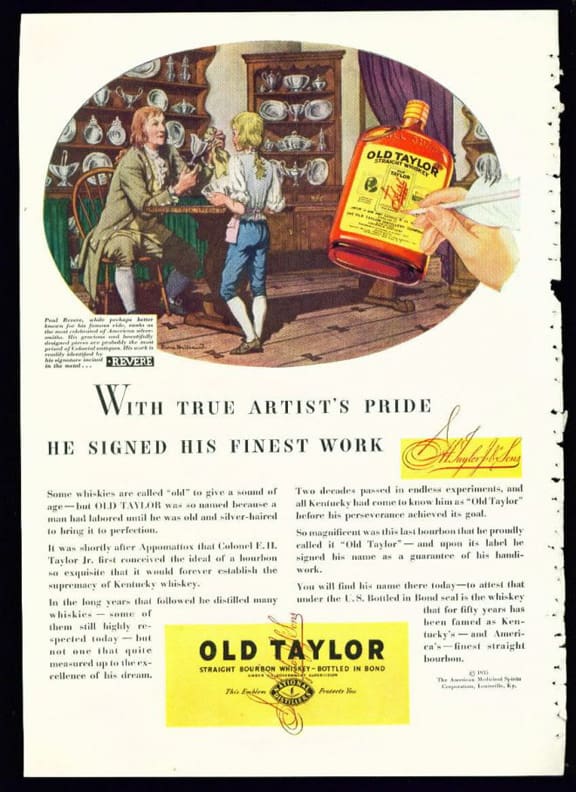
1935 Old Taylor Bourbon Whiskey advertisement with Paul Revere. Alignment with a famous American historical figure and laying the ground work for putting his signature on every label and advertisement. Both horizontal and vertical signatures present here.
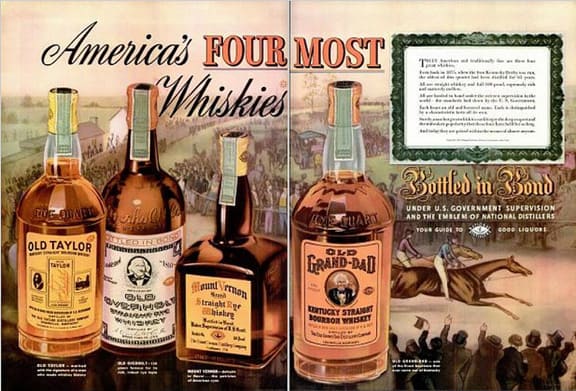
1938 vintage aAdvertisement – America’s Four-most Whiskies: Old Taylor, Old Overhold, Mount Vernon & Old Grand-Dad
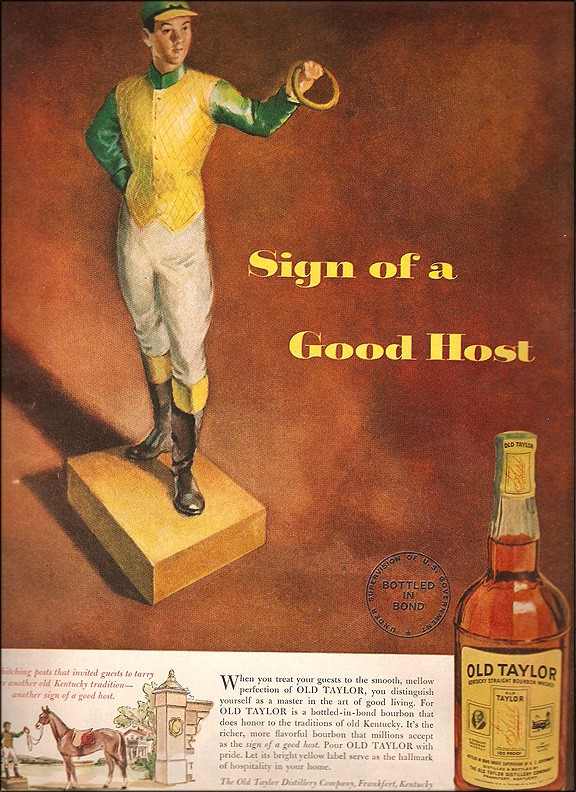
1951 OLD TAYLOR KENTUCKY Straight Bourbon Whiskey advertisement. The kentucky horse theme seems to dominate as from this point forwards.
 I was wondering if you could do an article on this Old Taylor bottle…maybe figure out where in the heck it came from? Dad wants to know really bad and no one has been able to identify or help him with it. He dug it in a OLD house a long, long time ago. Here it is if you want to do a write-up. Please find some info, that would be amazing. Dad would be really happy for Christmas!! He dug the bottle in the city of White Sulphur Springs, West Virginia or in proximity at least near an old brick Civil War house. Behind the house was a trash dump and he found it there approximately 40 years ago. He also found an anchor flask there and broken bitters bottles.
I was wondering if you could do an article on this Old Taylor bottle…maybe figure out where in the heck it came from? Dad wants to know really bad and no one has been able to identify or help him with it. He dug it in a OLD house a long, long time ago. Here it is if you want to do a write-up. Please find some info, that would be amazing. Dad would be really happy for Christmas!! He dug the bottle in the city of White Sulphur Springs, West Virginia or in proximity at least near an old brick Civil War house. Behind the house was a trash dump and he found it there approximately 40 years ago. He also found an anchor flask there and broken bitters bottles.
The bottle measures 9 1/2″ inches tall, the lip is 1 3/8″ wide and the outer diameter is 10 3/4″+/- and the base width is 3 1/8″. In block lettering in quotations on the front, it says “OLD TAYLOR” then in cursive “SH TAYLOR JR & SONS DISTILLERS, FRANKFORT, KY.”
I’ll have to really work on trying to figure out what that cork reads. I’m thinking it says 1770 but I’m not sure. I sent you a picture of that cork. The top of it does have Taylor written on it and a signature. The base is kind of rough and flat but smooth as well. They found this a long time ago over near that pre-Civil War house that nobody had been living in for a long time – Aaron Hanshew
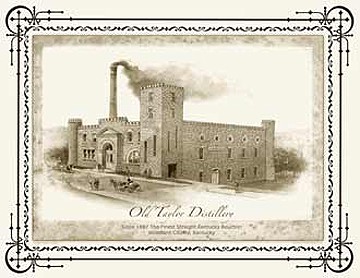 Aaron: What you have pictured is from E. H. Taylor, Jr. & Sons Distillers (not SH Taylor) from Frankfort, Kentucky. I would suspect the bottle is dated around 1884 to 1910 or so as this was when the “Sons” was used on the brand signature. It really could not be in the Civil War era as his sons had not been born. I have been unable to locate any other examples of your bottle.
Aaron: What you have pictured is from E. H. Taylor, Jr. & Sons Distillers (not SH Taylor) from Frankfort, Kentucky. I would suspect the bottle is dated around 1884 to 1910 or so as this was when the “Sons” was used on the brand signature. It really could not be in the Civil War era as his sons had not been born. I have been unable to locate any other examples of your bottle.
Old Taylor Bourbon was named in honor of Edmund Haynes Taylor, Jr. who lived from 1830-1923. Taylor was one of Kentucky’s original Bourbon aristocrats and was called the “father of the modern bourbon industry.” He was an industry leader who greatly advanced the quality of Kentucky Bourbon and safeguarded the Bourbon label from bogus producers. Taylor started and owned seven different distilleries throughout his career, the most successful being the O.F.C. and Carlisle distilleries, the forerunners of today’s Buffalo Trace Distillery.
In 1894, E. H. Taylor, Jr., and his sons, J.S. and Kenner, organized a corporation under the name of “E. H. Taylor, Jr. & Sons”. Soon thereafter their corporation acquired the distillery plant and all other assets of their former partnership and resumed the manufacture and sale of whiskey under the brands “Taylor” and “Old Taylor”. It appears that after 1910 the single word “Taylor” was seldom, if ever, used as the brand name, but thereafter the words “Old Taylor” and the script signature of the corporation “E. H. Taylor, Jr. & Sons” appeared conspicuously upon all labels and in all the advertising matter of the corporation.
His sons were named Jacob Swigert Taylor and Kenner Taylor.
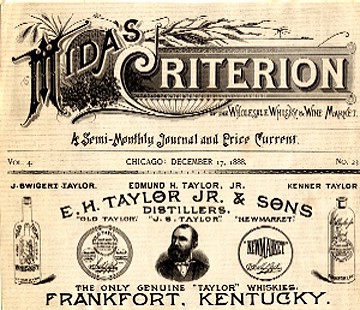
If you look closely, the bottle shape on the bottom right illustration on this Mida’s Criterion document is similar to the Hanshew example. Possibly the handle is behind the bottle and the bottle has a label wrapper.
What is fascinating about Taylor was his guarantee of quality in an industry that had virtually lost all credibility with consumers. He also built the amazing Old Taylor Castle on eighty-two acres along the banks of Glenn’s Creek which is south of Frankfort, in northern Kentucky. This castle was prominent in much of his advertising. The distillery was once the leading bourbon producer of the bluegrass state and was the first to reach the benchmark count of one million U.S. Government certified cases of straight Bourbon Whiskey.
You can also see remnants of the Taylor Distillery and castle if you visit Frankfort or take the Kentucky Bourbon Trail tour.
Taylor was also a descendant of two U.S. presidents, James Madison and Zachary Taylor, and because of this, Taylor had connections to Frankfort that benefited his self-interests. He later served as a longtime, 16-year mayor for Frankfort and as a state representative and senator.
Bottling house at 518 Broadway (1884). Distillers of Old Taylor Whiskey. Distillery at Taylorton, Glenn’s Creek, Woodford Co. (1910, 1912). Distilleries at Taylorton, Glenn’s Creek, Woodford Co. (1914-1919). Taylor also owned the OFC and Carlisle Distilleries near Frankfort.
The company used the brand names: “Carlisle”, “E. H. Taylor, Jr. & Sons”, “J. S. Taylor”, “Kentucky River”, “O. F. C.”, “O. F. C.”, “Old Taylor”, “Old Taylor, A Straight Kentucky Whiskey of Topmost Class”, and “Taylor.”
Business name timeline: E H Taylor Jr. Co. (1884), E H Taylor Jr. & Sons Co. Inc. (1908), E H Taylor Jr. & Sons (1910-1919)
Address timeline: 301 Main (1884), 518 Broadway (1908), 503-511 McClure Bldg. (1910), 503-511 United American Bldg. (1912), 503-511 McClure Bldg. (1914-1919) (Pre-pro.com)
Read More: Old Taylor Distillery
Read More: The Old Taylor Celebration at Buffalo Trace Distillery
Read More: History of the Old Taylor Distillery
Read More: NATIONAL DISTILLERS PRODS. CORP. v. K. TAYLOR DIST
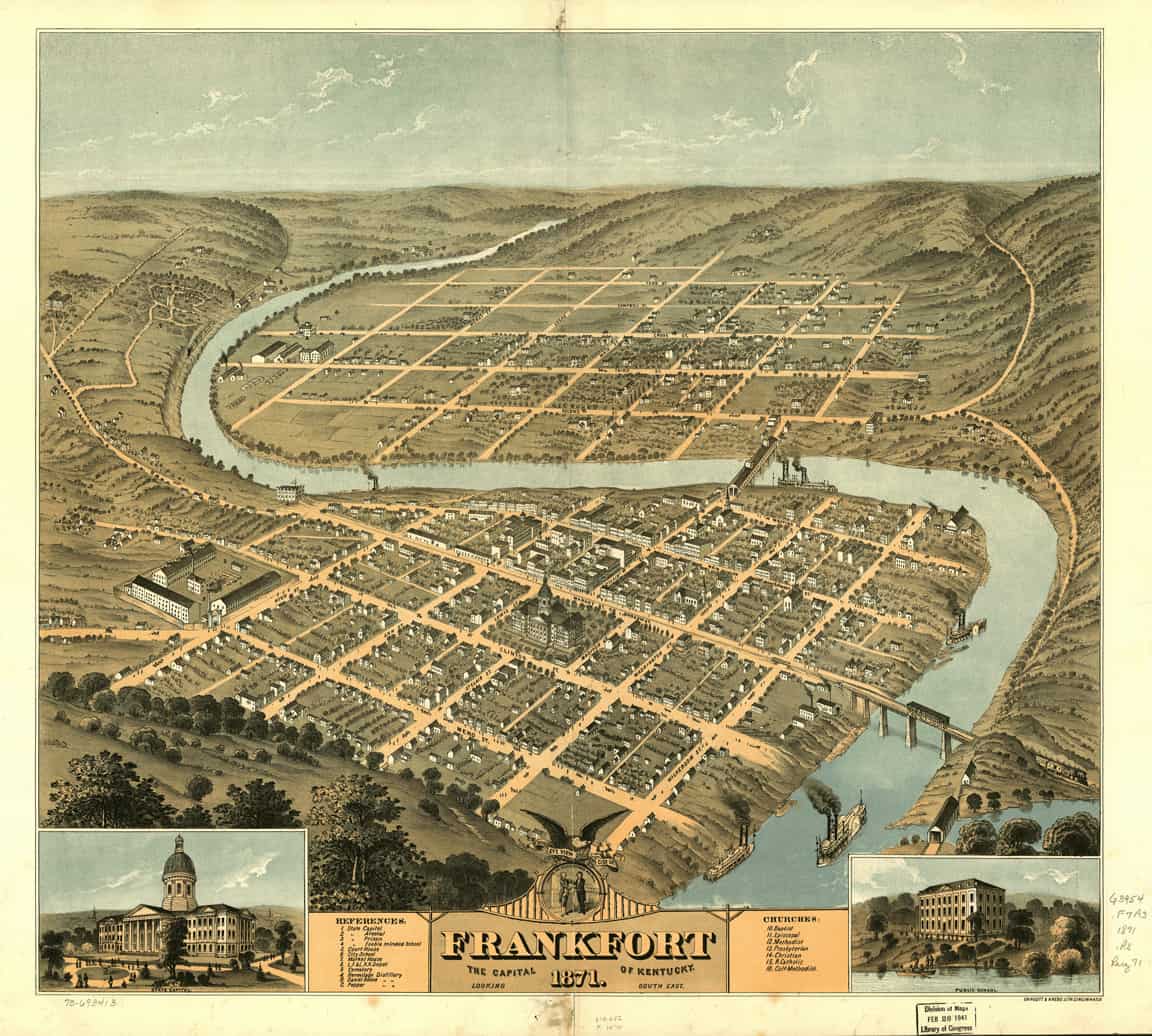
Colonel E. H. Taylor Jr. established the Old Taylor Distillery in 1887 in Frankfort, Kentucky. This was 16 years after this ‘birds eye’ map was illustrated. I think it still gives you an idea of the typography and layout of Frankfort. The Old Taylor Distillery was located south of town on Glenn’s Creek.
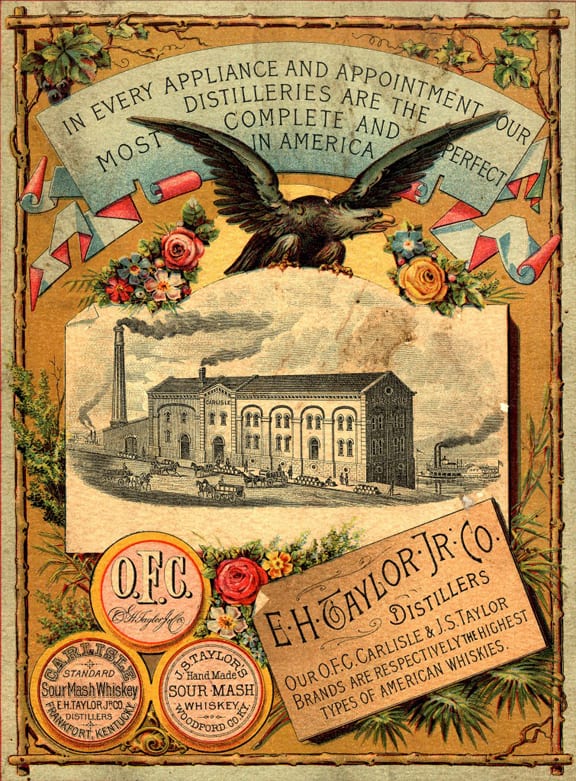
E.H. Taylor Jr. Co. Distillers back book cover in full color. Three products are listed: O.F.C., Carlisle Sour Mash Whiskey and J.S. Taylor Sour Mash Whiskey. This is a rather large distillery for the era. That would be the Kentucky River shown beyond the Distillery.
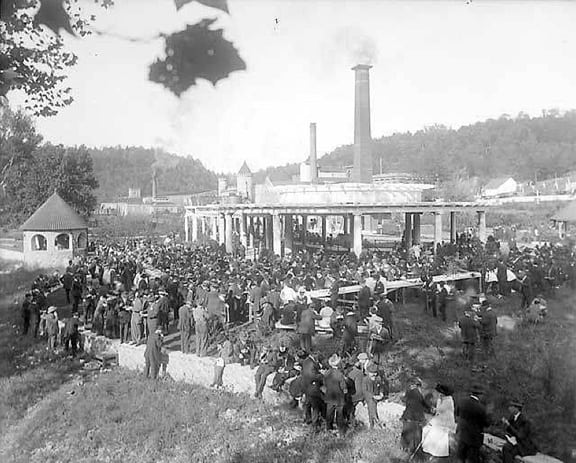
Old Taylor Distillery – “Burgoo for bankers at E. H. Taylor distillery. Crowd at tables in garden area. “
1915 – Kentucky Historical Society
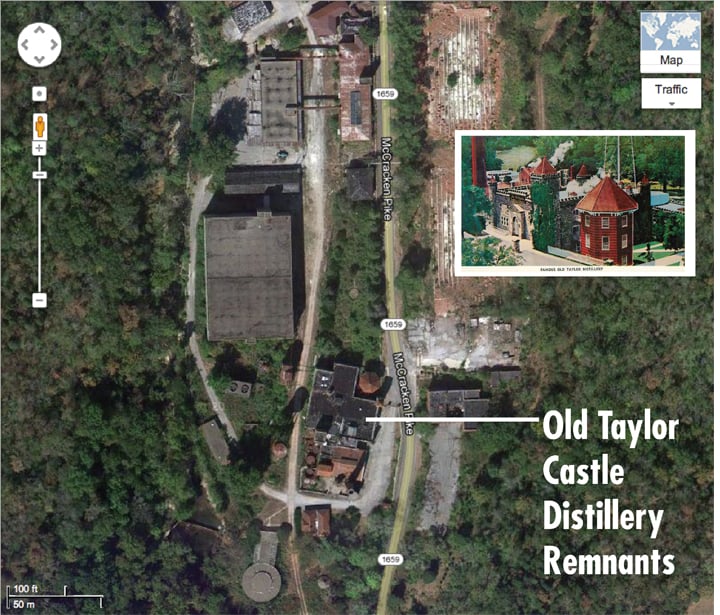
In this Google satellite shot you can see the remnants of the castle, smokestack and round corner tower. This would be a fun site to visit.
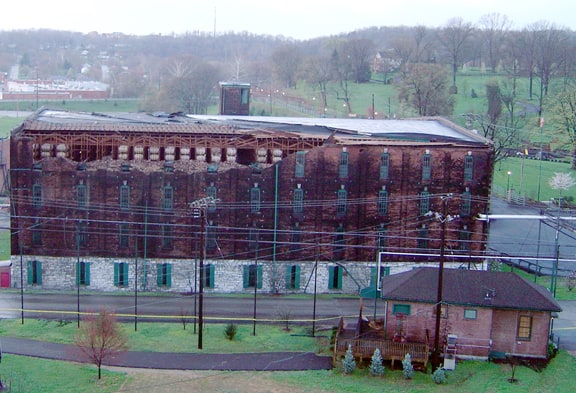
On April 2, 2006, a storm ripped through Kentucky, tearing apart two of Buffalo Trace’s warehouses. One was empty. One, Warehouse C, was full of 24,000 barrels of then-young, far-from-release E.H. Taylor Bourbon.
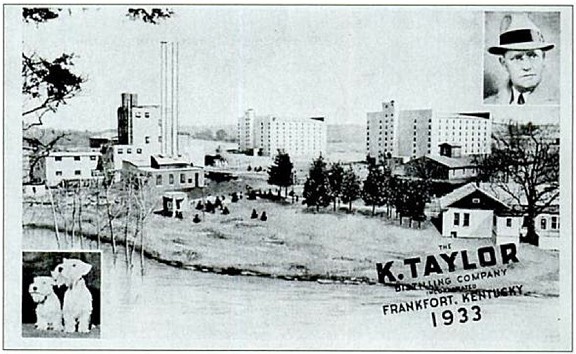
This odd postcard references a group including Kenner Taylor, one of Col. E.H. Taylor’s Jr.’s sons, purchased what remained of the Baker Distillery at the Forks of Elkhorn in 1933. Their brands included Kenner Taylor, Golden Bantam, and Forks of Elkhorn. Not sure what the dogs are about – Capital City Museum
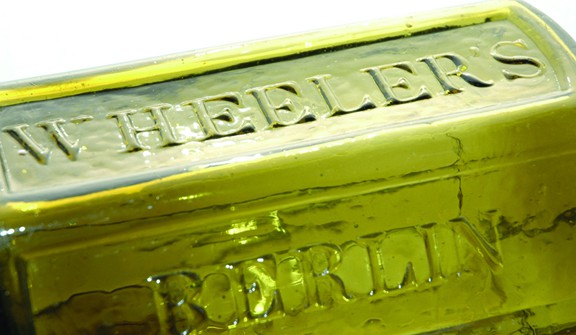
![]() The Wheeler’s Berlin Bitters is without a doubt, one of my favorite Bitters bottles. Being a native Baltimorean also influences this comment. Unfortunately, I do not know much about the bottle or brand other than what is documented in Ring & Ham (see below) and what has been reported over the years. This hexagonal, pontiled (iron and open pontil) bottle comes in two primary molds and some killer colors. I think most would easily say that this is a Baltimore Glass Works product from around 1850 to 1865.
The Wheeler’s Berlin Bitters is without a doubt, one of my favorite Bitters bottles. Being a native Baltimorean also influences this comment. Unfortunately, I do not know much about the bottle or brand other than what is documented in Ring & Ham (see below) and what has been reported over the years. This hexagonal, pontiled (iron and open pontil) bottle comes in two primary molds and some killer colors. I think most would easily say that this is a Baltimore Glass Works product from around 1850 to 1865.
Usually I look for advertising, labeled examples and genealogy information for the name. In this cast I can find nothing. This is really a puzzler. I am glad the bottle has ‘Baltimore’ prominently embossed on it or I would really be in the dark.
This post represents what is out there now. Hopefully somebody is holding some information so we can unlock the doors and figure out more about the Wheeler’s Berlin Bitters.
Read More: Leading up to Baltimore Glass Works
 Previously Unknown Pair of Whale Oil Lamps Ignite Bidders in Virginia:
Previously Unknown Pair of Whale Oil Lamps Ignite Bidders in Virginia:
A lucky auction staff find from a local estate was a bitters bottle that earned $9,900.
Embossed “Wheeler’s Berlin Bitters Baltimore,” it was a brilliant deep yellow-green, hexagonal form with two blank panels, applied lip and large rough pontil. With a nicely whittled surface, it stood 9 3/4 inches high. – Antiques and the Arts
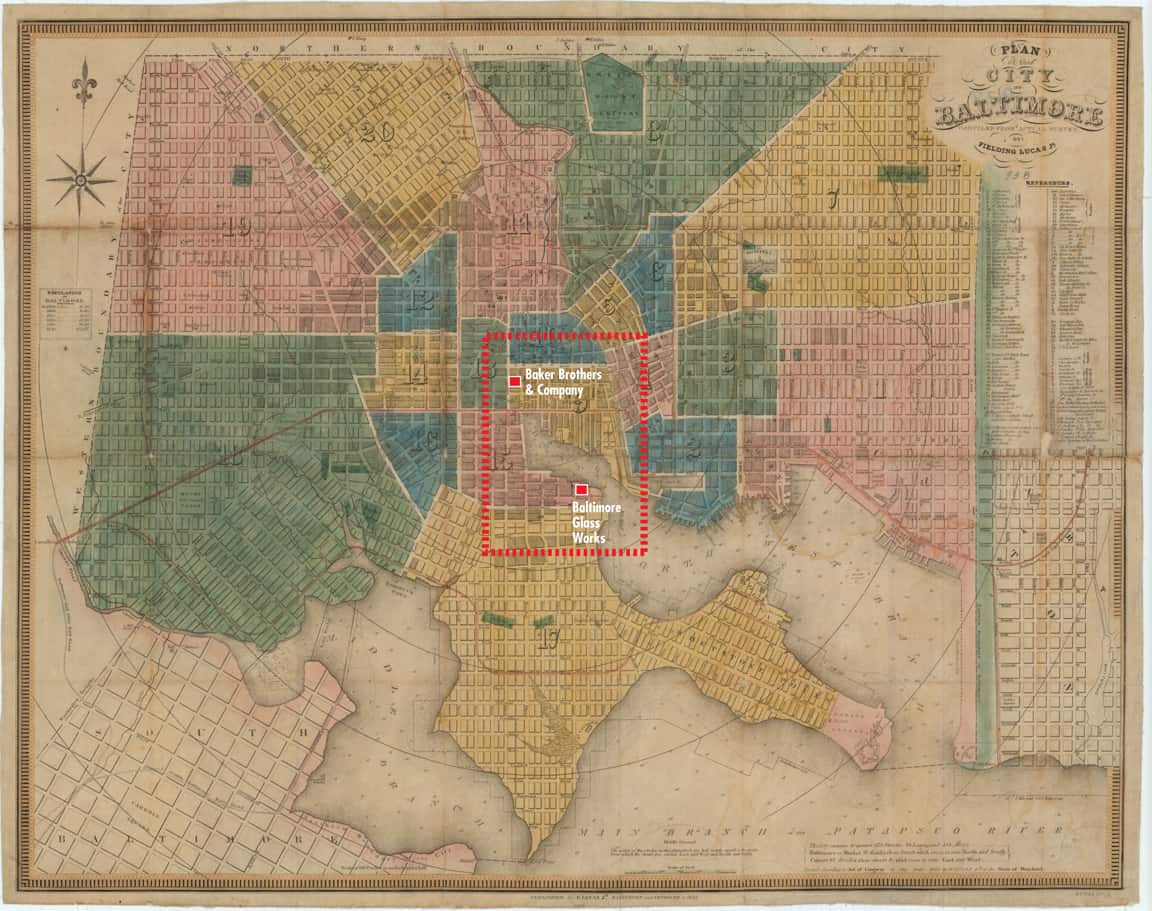
Baltimore City Map 1850 – The site of the Baltimore Glass Works was on the harbor at Hughes Street (now Key Highway) between Henry and Covington Streets, where its successor company, the Federal Hill Glass Works of Baker Bros. & Co. remained as late as 1873. The wholesale and retail arm of Baker Brothers & Company was located at 32 and 34 S. Charles Street in downtown Baltimore City.
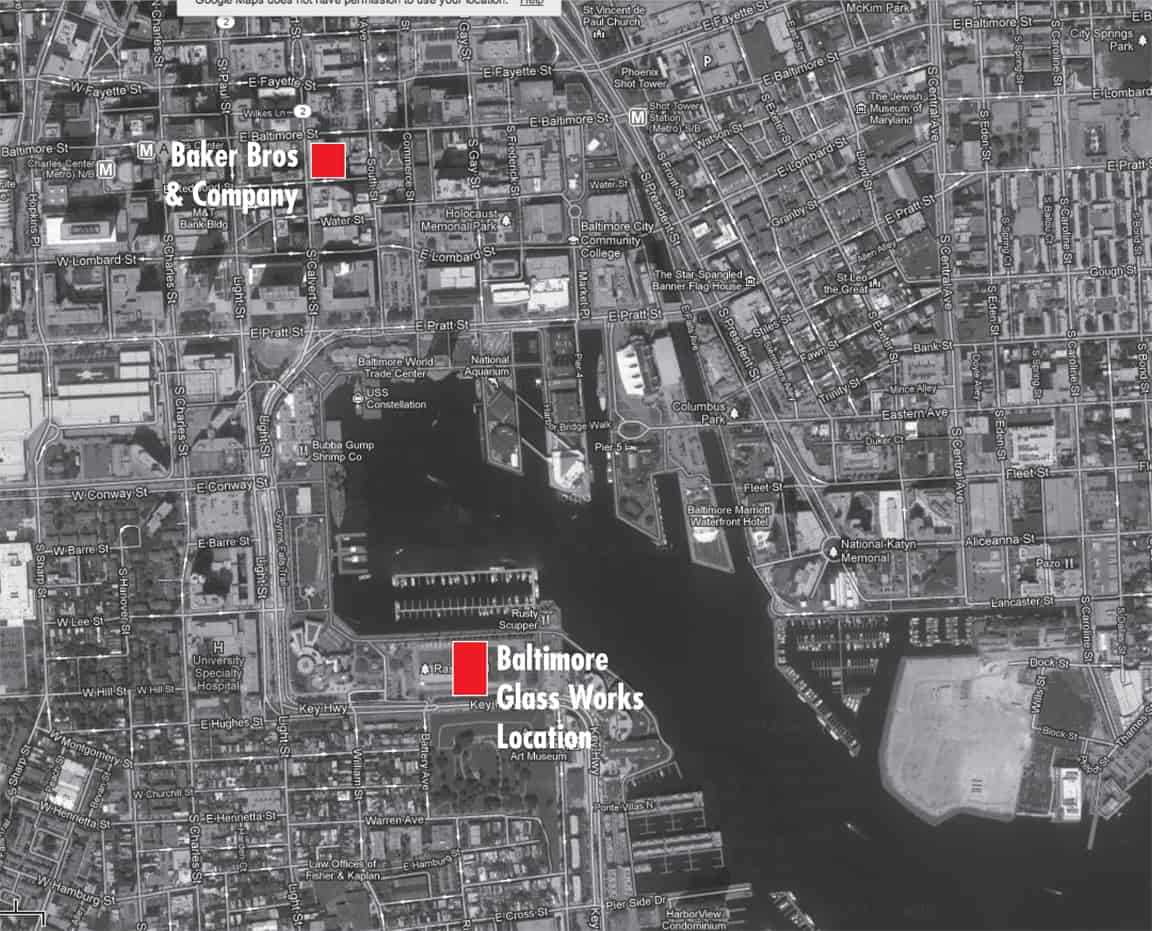
Google Earth Baltimore City 2011 – The site of the Baltimore Glass Works was on the harbor at Hughes Street (now Key Highway) between Henry and Covington Streets, where its successor company, the Federal Hill Glass Works of Baker Bros. & Co. remained as late as 1873. The wholesale and retail arm of Baker Brothers & Company was located at 32 and 34 S. Charles Street in downtown Baltimore City. One can only imagine all of the great bottles under the 20th century skyscrapers, parking garages and new freeways in Baltimore.
The Carlyn Ring and W.C. Ham listing in Bitters Bottles is as follows:
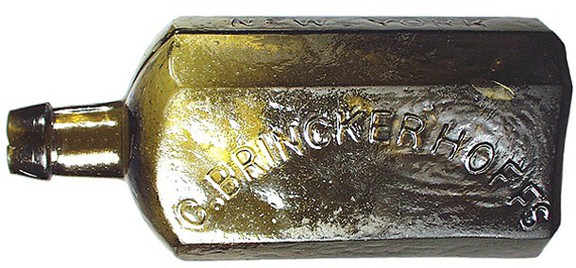
![]() I was surprised to find out that the ‘B’ in ‘William B. Moffat’, of John Moffat Phoenix Bitters fame, stood for ‘Brinckerhoff’. This unusual name must be somehow related to the ‘C. Brinckerhoff’s Health Restorative‘ bottle pictured above. The bottles overlap in the same time period of 1845 – 1849 and they are also both New York City products.
I was surprised to find out that the ‘B’ in ‘William B. Moffat’, of John Moffat Phoenix Bitters fame, stood for ‘Brinckerhoff’. This unusual name must be somehow related to the ‘C. Brinckerhoff’s Health Restorative‘ bottle pictured above. The bottles overlap in the same time period of 1845 – 1849 and they are also both New York City products.
Well unfortunately, it is not that easy to connect as I can find no reference to ‘John Moffat Phoenix Bitters’ in ‘Health Restorative’ material or vice versa. This really is a puzzler for me as the C. Brinckerhoff is of similar style, color and typography with the Phoenix Bitters (see picture below). Even the pricing conventions such as listing the price on the bottle is similar.
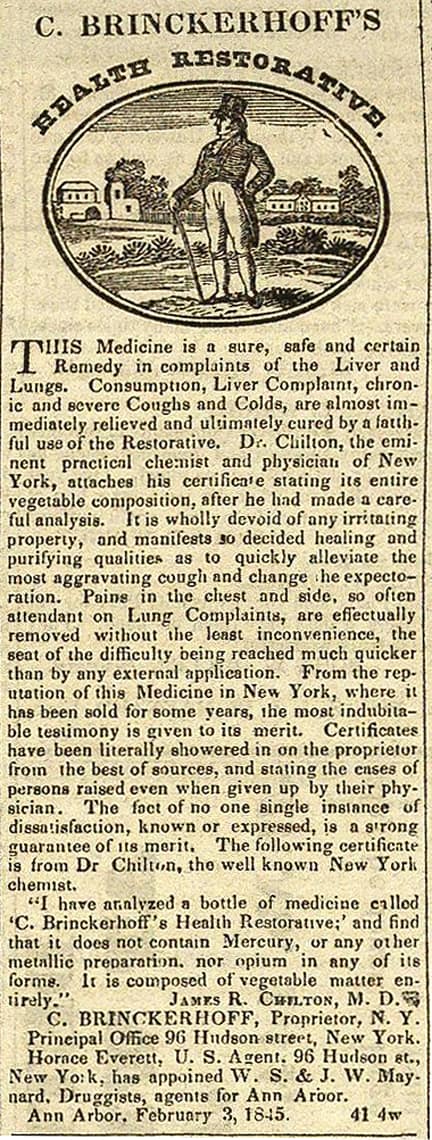
1845 advertisement for C. Brinckerhoff’s Health Restorative in the Signal of Liberty (Ann Arbor). Really neat that the well-known chemist, Dr. Chilton was engaged to provide an anchor testimony for the product. – Ann Arbor Gigital Library.
Read More: Jack Stecher and his John Moffat Phoenix Bitters
Read More: John Moffat Phoenix Bitters Support
What we do know is the the ‘C’ in ‘C. Brinkerhoff’ is for ‘Cornelius’ as in a 1842 Directory listing there is a notation for Cornelius Brinckerhoff, proprietor of the Health Restorative located at 589 Broome with a residence at 70 Eldridge. There is also reference of a Brinckerhoff’s Almanac for 1846 which I can not find an example of.
Cornelius Brinckerhoff began to prepare and sell proprietary medicines in New York City around 1840. He retired after a decade of successfully marketing his Health Restorative, a Pile Injection Fluid and the Celebrated Ulcer Specific (1846). This product was advertised between 1845 and 1849 as a cure for consumption (tuberculosis), liver complaint, asthma, colds, coughs, and pains in the side and chest. The bottle usually has a crudely applied mouth and was blown in a two-piece “hinge” mold (as indicated by the mold seam crossing diagonally across the entire base). There is usually a sand pontil scar.
John Moffat was born on 03 August 1788 and died in New York City on 03 November 1863. He was married in Troy, New York on 10 September 1816 to Rachel Marie Brinckerhoff, (daughter of Isaac Brickerhoff and Sophie Quackenbos). Their son was William Brinkerhoff Moffat.
Maybe Cornelius Brinkerhoff was a son of John and Rachel Marie Moffat which would make him Williams brother though I see no support for this in Ancestry.com. The Moffat family will also break up and sue each other over the Moffat brand in 1863. What a mystery! I bet someone out there can help tie or disconnect these brands.
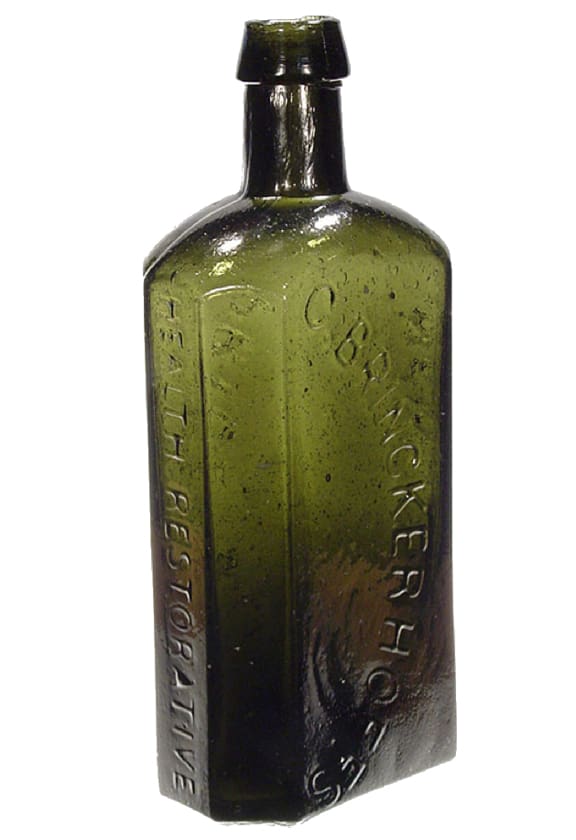
Medium to deep olive green C. BRINCKERHOFF’S HEALTH RESTORATIVE PRICE $1.00 NEW YORK – GreatAntiqueBottles.com
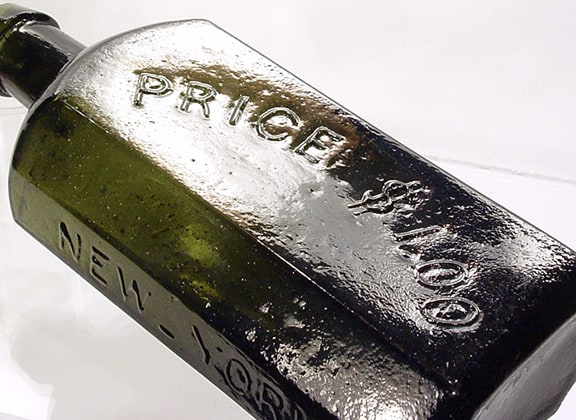
Medium to deep olive green C. BRINCKERHOFF’S HEALTH RESTORATIVE PRICE $1.00 NEW YORK with sand chip pontil – GreatAntiqueBottles.com
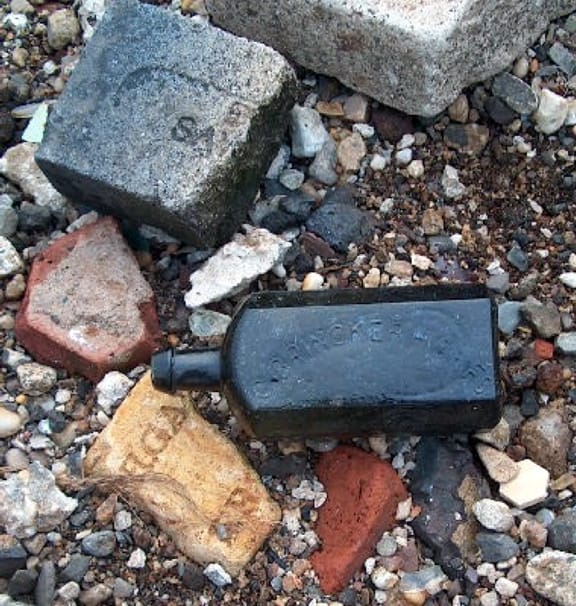
Scott Jordan dug this rare Brinckerhoff’s bottle shown here in Jersey City, New Jersey. The crucible, fire brick, and cullet came from the same site. – The Potomac Pontil – 2004 (Read Story)
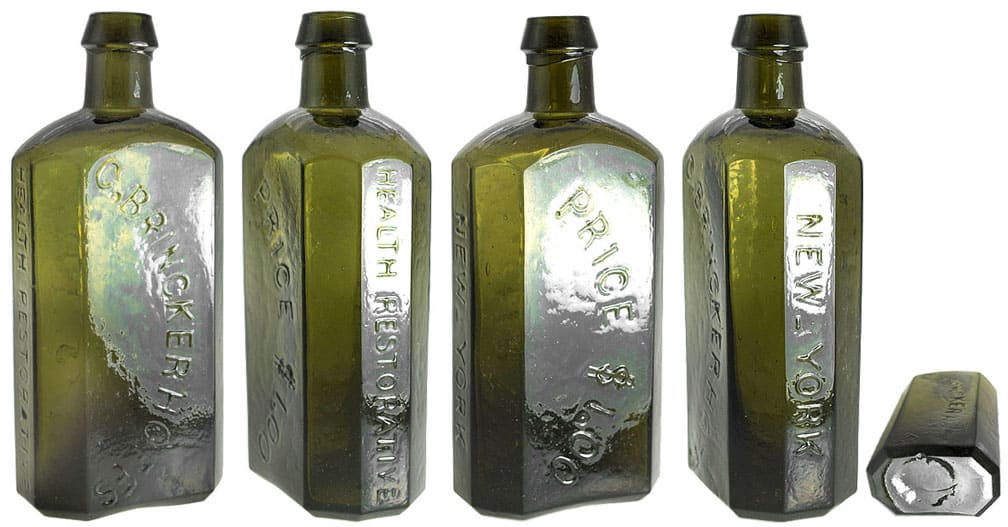
“C. BRINCKERHOFFS – HEALTH RESTORATIVE – PRICE $1.00 – NEW_YORK”, (Odell pg. 47), New York, ca. 1840 – 1860, medium yellowish olive green, 7 1/4”h, pontil scarred base has a small open bubble, applied tapered collar mouth. Lightly cleaned to its original luster and about perfect condition. Some light scratches exist on the Price $1.00 panel. Most of the known examples of this bottle, and their are a number of them, are deep olive green or deep olive amber in color. But not this bottle, you are bidding on a bottle in an exceptional color, considerably lighter then most. Add to that a very bold impression and you have one very desirable bottle! – Glass Works Auction #96
This is the second weekly round-up of some really nice photography from various facebook and other glass sites. These pictures are amazing. It is so nice to see such great care with topic selection, composition and lighting. Well done to each of you.
Make sure you visit the Fresh Peach Gallery which represents the best of the best pictures from 2012.
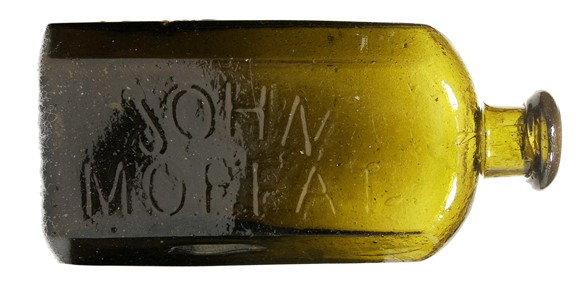
![]() This post developed to show support information and imagery for John Moffat Phoenix Bitters.
This post developed to show support information and imagery for John Moffat Phoenix Bitters.
John Moffat, born 3 August, 1788; died New York City, 3 November, 1863; married in Troy, New York, 10 September 1816 to Rachel Marie Brinckerhoff, (daughter of Isaac Brickerhoff and Sophie Quackenbos).
John Moffat invented and first started selling Moffat’s Phoenix Bitters in New York City around 1834 or 1835 (according to almanacs and advertisements). His remedies were among the many bitters brands flooding the 19th-century market, claiming a host of medicinal virtues for the thousands of customers seeking relief. No doubt their high alcohol content made these products especially appealing to the public.
Moffat advertised extensively (see examples below) and Phoenix Bitters soon became a success. Touted the “Universal Cure,” when taken at night Moffat’s formula was said to “promote insensitive respiration and relieve the system of febrile action and feculent obstructions as to produce delightful convalescence in the morning.”
His son William B. Moffat assumed the business in 1838, and had the product patented in 1862.
John Moffat brought suit against his son William for a dissolution of the copartnership (see newspaper transcript below from the New York Times)
William Brinckerhoff Moffat, born New York City, 17 March, 1818; died New York City, 11 April, 1862; married New York City 1 July, 1854 to Julia Augusta Mitchell, (daughter of Robert Mitchell) born 1831; died New York City, 3 September, 1866.
William B. Moffat assumed the business in 1838, and had the product patented in 1862. However, John Moffat’s name continued to be embossed on the bottles. By 1845, the company had introduced at least one other remedy, Moffats’s Vegetable Life Pills, along with Moffat’s Almanac, a popular advertising medium to promote patent medicines, including bitters. Moffat’s Agricultural Almanac for 1845 featured “certificates of remarkable cures performed by Moffat’s remedies.”
As noted in a newspaper advertisements of the era, “no traveler by land or sea” should be without John Moffat’s & Cos medicines, “essential to the system undergoing changes from a variation of climate” and “also in allying sea-sickness.”
Moffat was listed as Physician and sole proprietor of Moffat’s Life Pills and Phoenix Bitters, Room P in the Moffat’s Building, 333 Broadway (see New York building picture below), residence, 125 Fifth Avenue.
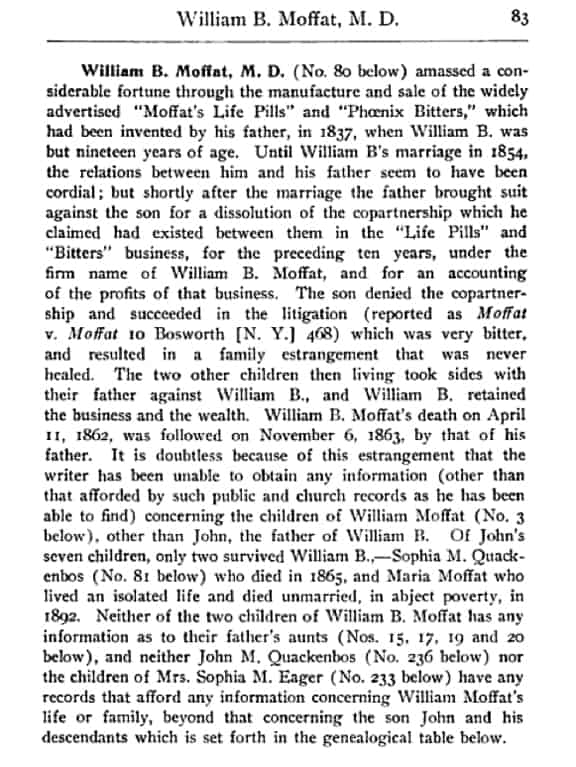
Moffat Genealogies, Descent from Rev. John Moffat from Ulster County, New York by R. Burnham Moffat – 1909
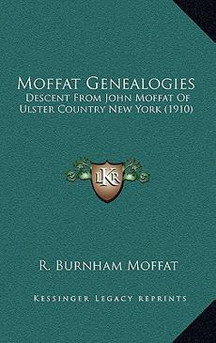 There are a number of examples of Moffat Genealogies: Descent from REV. John Moffat of Ulster County, New York available for purchase. The Moffat name is well researched and documented.
There are a number of examples of Moffat Genealogies: Descent from REV. John Moffat of Ulster County, New York available for purchase. The Moffat name is well researched and documented.
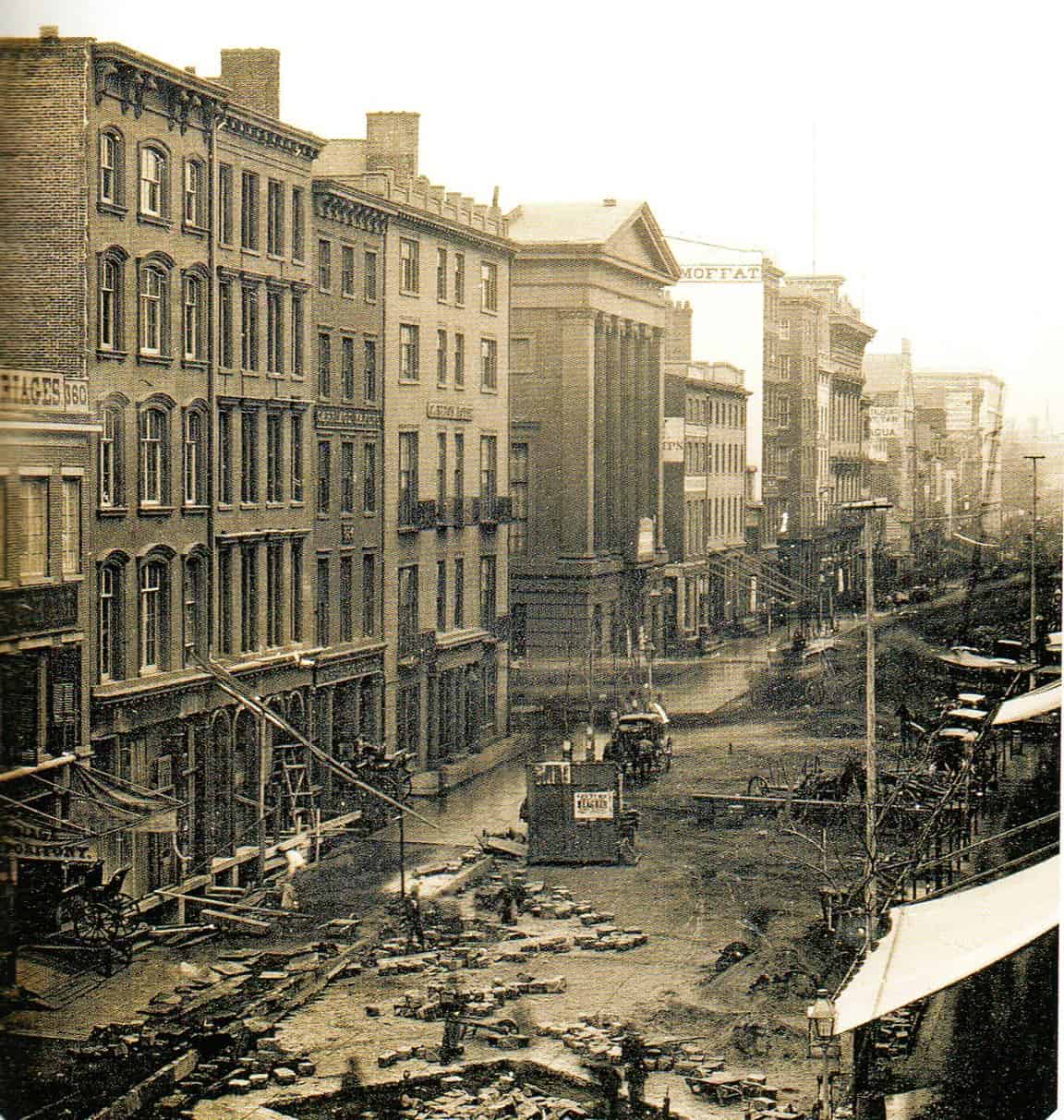
Look carefully at the MOFFAT letters painted on the top right side of the back building. Taken at Broadway between Franklin and Leonard Streets, Believed to date to May 1850. From New York: An Illustrated History, by Ric Burns and James Sanders. Moffat and his family lived on Union Square, but he also owned the building that bore his name at 337 Broadway.
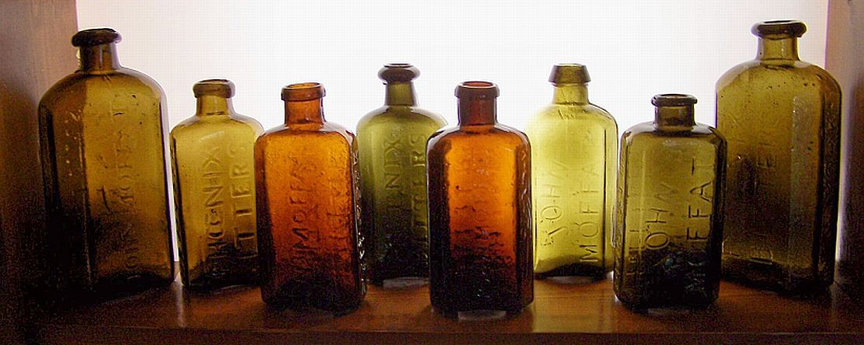
Impressive group of the various JOHN MOFFAT PHOENIX BITTERS bottles – Stecher Collection (Read more: Jack Stecher and his John Moffat Phoenix Bitters)
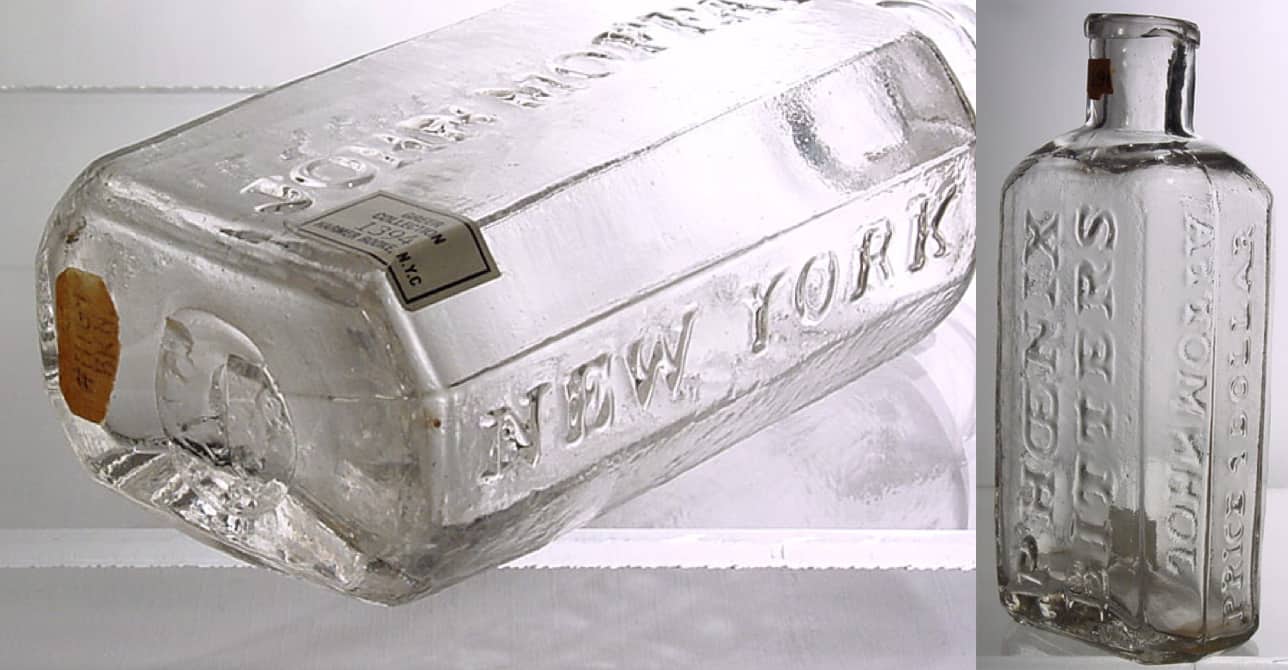
M 113 JOHN MOFFAT PRICE 1 DOLLAR PHOENIX BITTERS NEW YORK, clear, solid pontil, out folded lip, bold embossing, ex: Gardner Collection, lot 1615, ex: Greer Collection, lot 1394, extremely rare, possibly two examples – greatantiquebottles.com
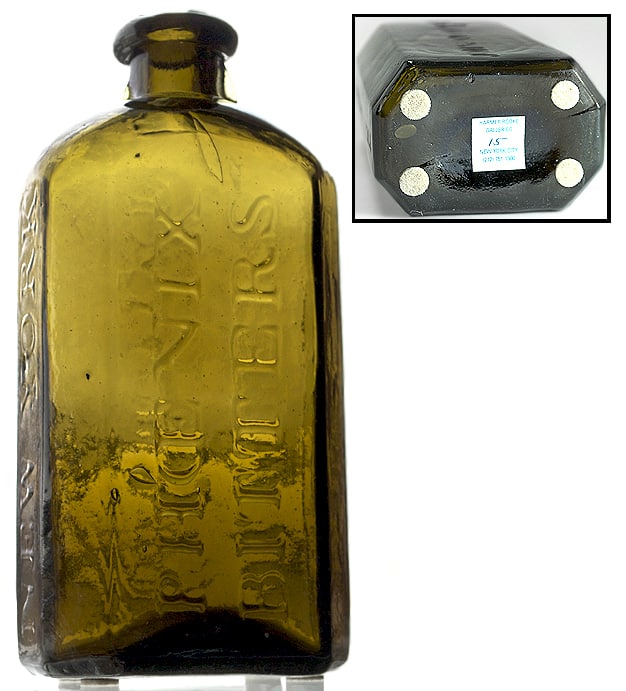
JOHN MOFFAT – NEW YORK – PHOENIX / BITTERS – PRICE 2 DOLLARS”, (Ring/Ham, M-109), (Odell, pg. 170), New York, ca. 1840 – 1860, yellowish olive amber, 7”h, improved pontil scarred base, applied ring mouth. A tiny in making flake is off the inside edge of the base, otherwise in sparkling pristine perfect condition. A very crude applied lip does not completely cover the sheared lip. Also note the two tiny fully intact ‘wings’ of glass on the side of the neck that protruded through the mold seam. There are two variants of the 2-dollar phoenix bitters and this is by far the rarest! A high percentage of the known 2-dollar phoenix bitters are dug and cleaned, so it is very refreshing to find one like this that wasn’t! $5,700 – Glass Works Auctions Direct Sale (2019) (see below)
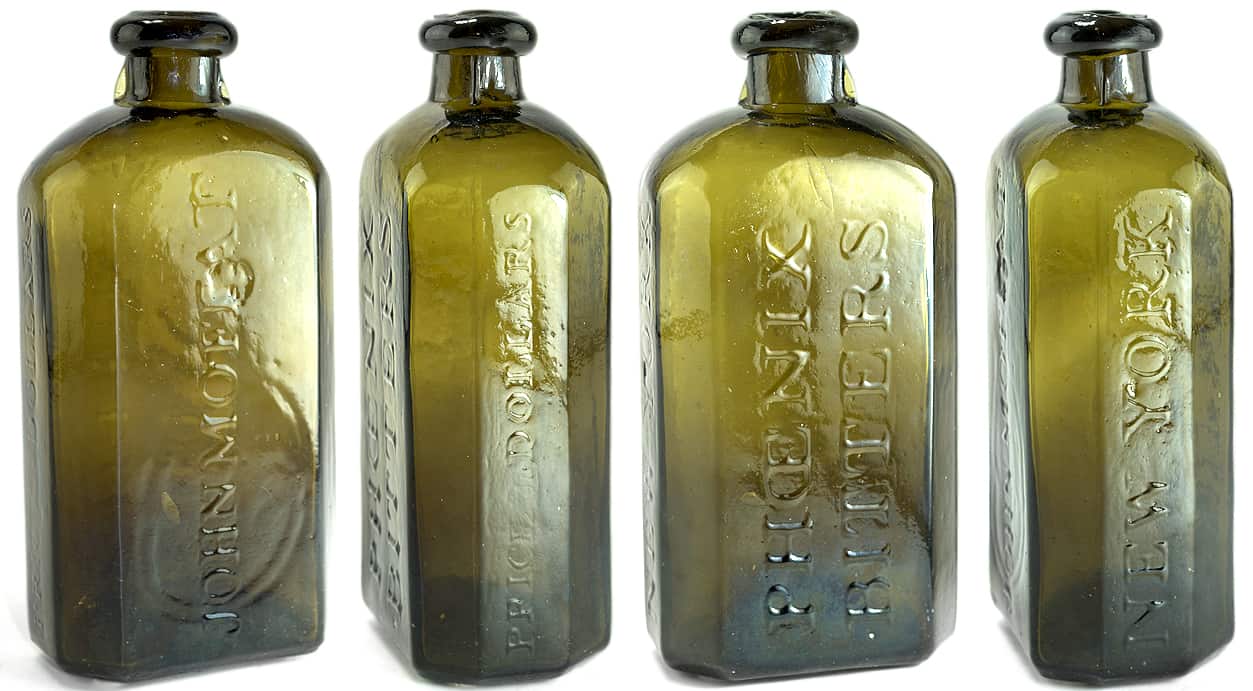
JOHN MOFFAT – NEW YORK – PHOENIX / BITTERS – PRICE 2 DOLLARS”, (Ring/Ham, M-109), (Odell, pg. 170), New York, ca. 1840 – 1860, yellowish olive amber, 7”h, improved pontil scarred base, applied ring mouth. A tiny in making flake is off the inside edge of the base, otherwise in sparkling pristine perfect condition. A very crude applied lip does not completely cover the sheared lip. Also note the two tiny fully intact ‘wings’ of glass on the side of the neck that protruded through the mold seam. There are two variants of the 2-dollar phoenix bitters and this is by far the rarest! A high percentage of the known 2-dollar phoenix bitters are dug and cleaned, so it is very refreshing to find one like this that wasn’t! $5,700 – Glass Works Auctions Direct Sale (2019) (see above)
John Moffat vs. Julia A. Moffat, widow of the late William B. Moffat, et al. — This action was commenced in 1854 by John Moffat, claiming an interest as partner in the business owned by his son, of manufacturing and selling “Moffat’s Life Pills and Phoenix Bitters,” and was tried before Justice Bosworth, at a Special Term of the Court, in 1857, then occupying the attention of the Court for over two weeks. On the trial the parties to the action were examined as witnesses in their own behalf, and the trial resulted in a judgment in favor of the defendants.
An appeal was taken by the plaintiff from that judgment to this branch of the Court, and, pending the appeal, the then defendant, William B. Moffat, died. The action was then revived by his executor, in order that the appeal should dispose of the case.
The appeal was argued at the last General Term, when decision was reserved.
The Court now rendered decision, affirming the judgment of Justice Bosworth in the Court below.
P.G. Clarke and Chas. O’Conor, for plaintiff; G. Tillotson and Jas. T. Brady, for defendants.
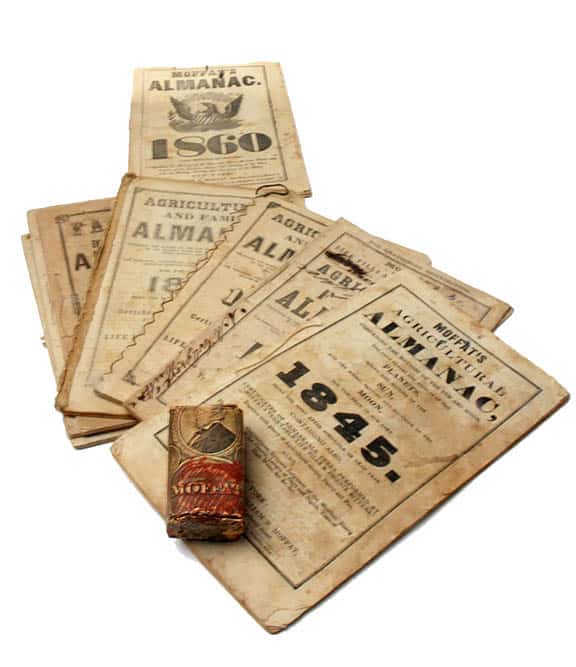
Eight early Moffat Almanacs for years 1845, 1847, 1848, 1849, 1852, 1853, 1856, and 1860. Also included is an early un-opened box of Moffat’s Life Pills, c. 1850. – American Glass Gallery | Auction #21
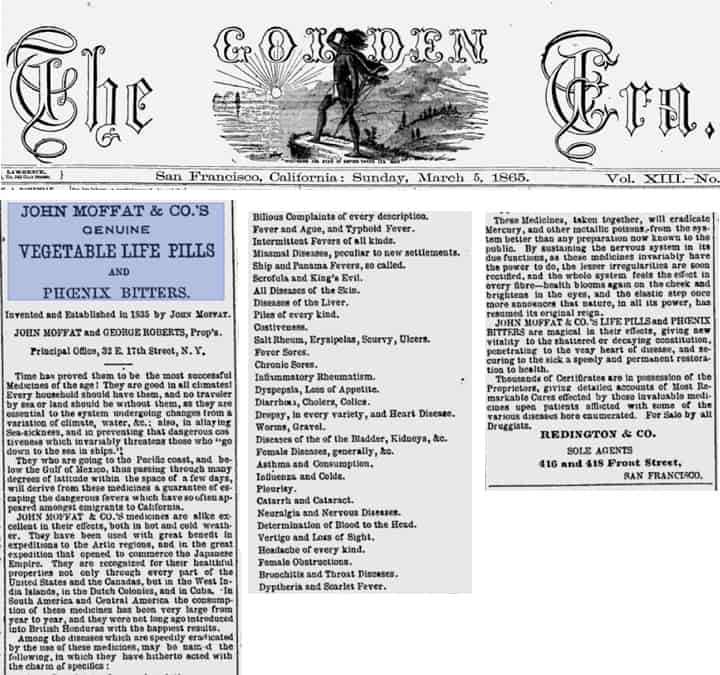
Advertisement for John Moffat & Co’s Genuine Vegetable Life Pills and Phoenix Bitters – The Golden Era, San Francisco, California, Sunday, March 5, 1865
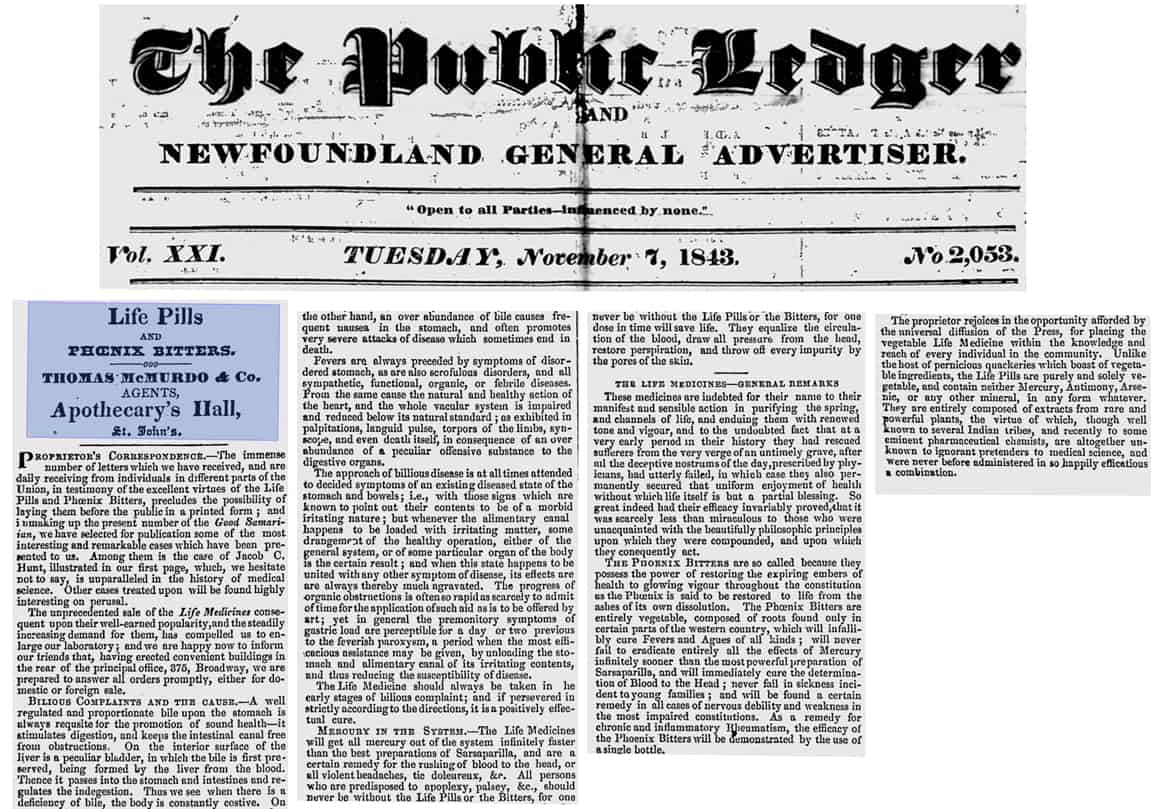
Interesting, long winded and early advertisement and testimonial for Life Pills and Phoenix Bitters in The Public Ledger and Newfoundland General Advertiser on Tuesday, November 7, 1843
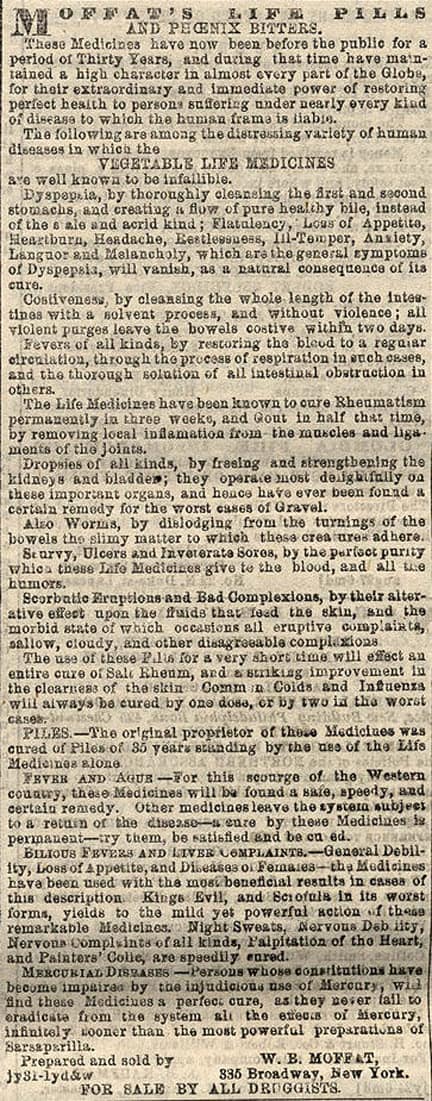
Moffat’s Life Pills and Phoenix Bitters advertisement – The Daily Evening Express, Lancaster, PA, December 6, 1860.
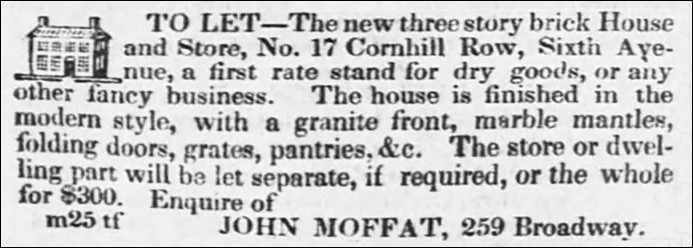
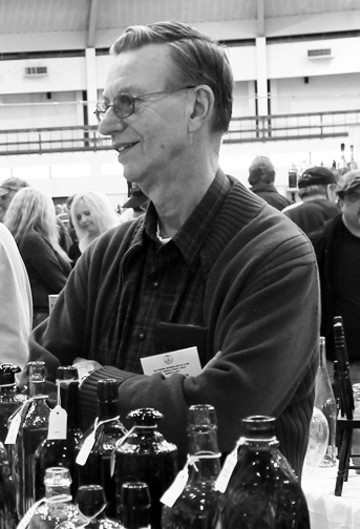
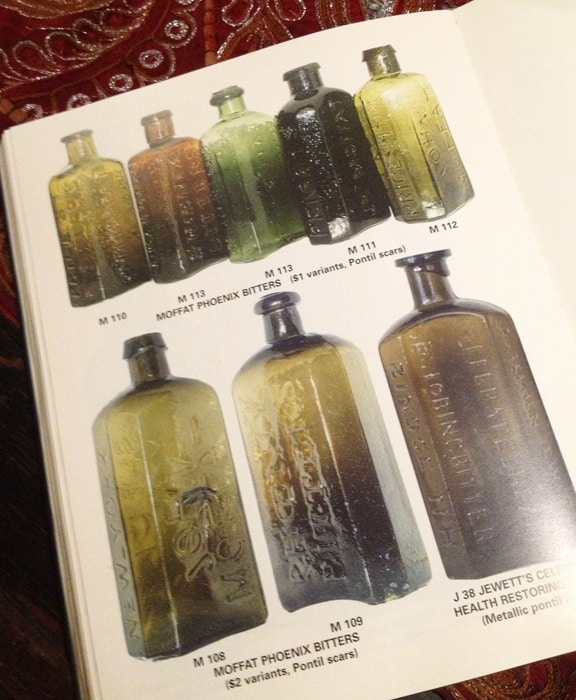
Page 68 fron the Carlyn Ring and Bill Ham Bitters Bottle Supplement
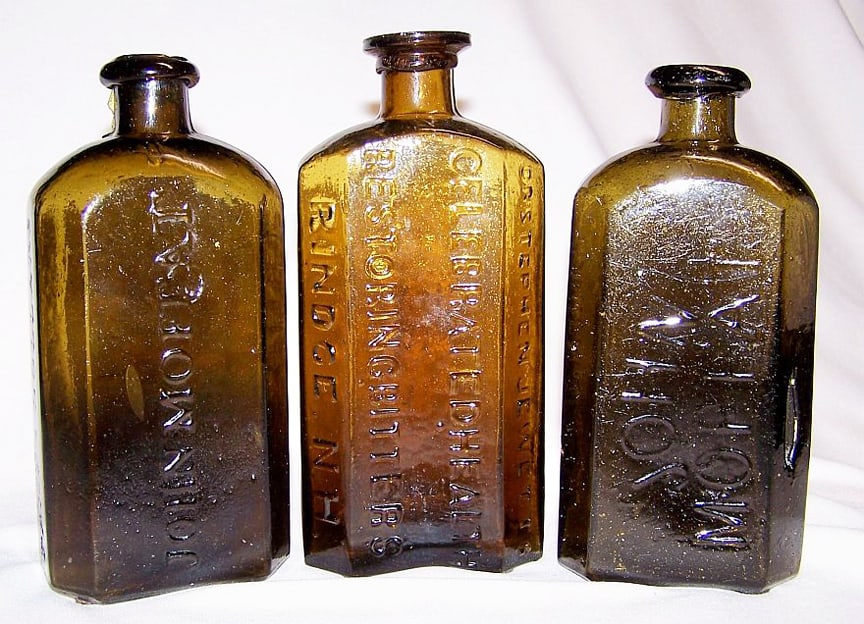
DR. JEWETT”S BITTERS flanked by JOHN MOFFAT PHOENIX BITTERS – Stecher Collection
Read More: John Moffat Phoenix Bitters Support
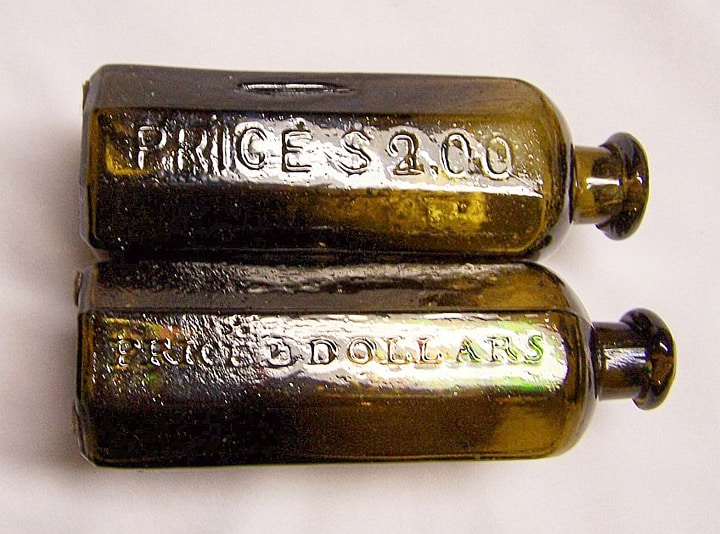
M 108 and M-109 (see above) JOHN MOFFAT NEW YORK PHOENIX BITTERS photograph comparing price embossings together – Stecher Collection
M 111 JNO MOFFAT PRICE 1 $ PHOENIX BITTERS NEW-YORK
JNO MOFFAT // PRICE 1 $ // PHOENIX BITTERS // NEW-YORK //
5 1/2 x 2 1/2 x 1 3/4 (4 1/4) 9/16 & 11/16
Rectangular, Dark amber, STC and Rolled collar, Applied mouth, Rough pontil mark, Extremely rare
Lettering reads base to shoulder. Bevels are two sizes. 9/16 and 11/16. Letters are very crude and very high in relief. The 1 and $ are in reverse order. The $ has only one vertical line. This is the rarest of the John Moffat Phoenix Bitters bottles.